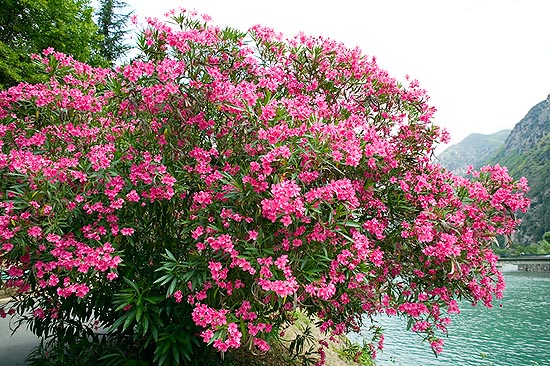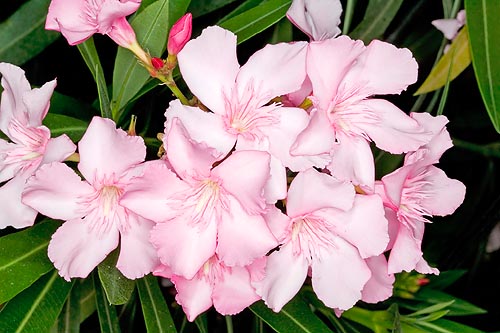Family : Apocynaceae

Text © Pietro Puccio

English translation by Mario Beltramini

Nerium oleander © Giuseppe Mazza
The Nerium oleander L. (1753) is native to Europe (Portugal, Spain, Balearic Islands, France, Italy, Sardinia, Sicily, Malta, Albania, Slovenia, Croatia, Bosnia, Serbia, Macedonia, Montenegro, Greece, European Turkey) ; Africa (Morocco, Algeria, Tunisia, Libya, Niger, Ethiopia) ; Asia (Israel, Jordan, Lebanon, Syria, Cyprus, Turkey, United Arab Emirates, Oman, Iraq, Iran, Afghanistan, Pakistan India, Nepal, Southern China, Myanmar).
Derivation of the name: The name of the genus comes from the Greek “neron” = water, with possible reference to the shingles and the banks of the rivers where it more frequently grows up; the name of the species should come from the Late Latin “lorandrum”, corruption of the Greek word ‘rhododendron” = pink tree, with possible reference to the most frequent colour of its flowers.
Common names: “oleandro”, “mazza di San Giuseppe” (Italian); “oleander”, “rose bay”, “rose-laurel” (English); “laurier rose”, “oleander” (French); “Oleander” (German); “adelfa”, “balandre”, “laurel rosa”, “pascua” (Spanish); “espirradeira”, “loendro”, “oleandro” (Portuguese); “kyochiku-to” (Japanese).
Evergreen shrub tall up to 5-6 m, with green stems tending to become greyish while ageing; the leaves are lanceolate-linear, long up to 18 cm and 2-3 cm broad, coriaceous, of dark green colour, opposite or in verticils of three. Terminal inflorescences carrying five-lobed flowers of about 5 cm of diameter with a “fringe” at the centre of the corolla, most frequently pink coloured, but also white, yellow and red, more or less perfumed. The fruits are spindle-shaped follicles long up to 20 cm containing several seeds long up to about 7 mm, provided with a tuft of hair in order to favour their dispersal. It multiplies by seed, semi-woody cutting in summer and air layering.
Plant amply diffused as ornamental due to its abundant blooming in spring and summer, its adaptability to whatever type of soil, even poor, the resistance to long period of drought, to low temperatures (up to about -10°C, even if damage to the aerial part) and to however hostile habitats, such as roads and motorways, where it is frequently employed as traffic island.

Flowers of Nerium oleander © Giuseppe Mazza
The oleander is considered as one of the most poisonous plants due to the presence in all its parts of several highly toxic substances, between which the oleandrin, a cardiac glycoside which is also, at very low dosage, employed in medicine. Its toxicity is maintained also when dried up.
Synonyms: Nerium indicum Mill. (1768); Nerium latifolium Mill. (1768); Nerium lauriforme Lam. (1779); Nerium odorum Sol. in W.Aiton (1789); Oleander indica (Mill.) Medik. (1790); Oleander vulgaris Medik. (1790); Nerium odoratum Lam. (1792); Nerium floridum Salisb. (1796); Nerium verecundum Salisb. (1796); Nerium carneum Dum.Cours. (1811); Nerium flavescens Spin (1812); Nerium grandiflorum Desf. (1815); Nerium luteum Nois. ex Steud. (1821); Nerium odoratissimum Wender. (1831); Nerium splendens Paxton (1837); Nerium thyrsiflorum Paxton (1837); Nerium mascatense A.DC. in A.P.de Candolle (1844); Nerium kotschyi Boiss. (1846); Nerion oleandrum St.-Lag. (1880); Nerium japonicum Gentil, (1907); Nerium indicum var. leucanthum Makino (1940); Nerium indicum var. lutescens Makino (1940); Nerium indicum var. plenum Makino (1940); Nerium oleander var. indicum (Mill.) O.Deg. & Greenwell in O.Degener (1952); Nerium indicum f. leucanthum (Makino) Okuyama (1955); Nerium indicum f. lutescens (Makino) (1955); Nerium indicum subsp. kotschyi (Boiss.) Rech.f. (1974); Nerium oleander subsp. kurdicum Rech.f. (1974).
→ To appreciate the biodiversity within the APOCYNACEAE family please click here.
